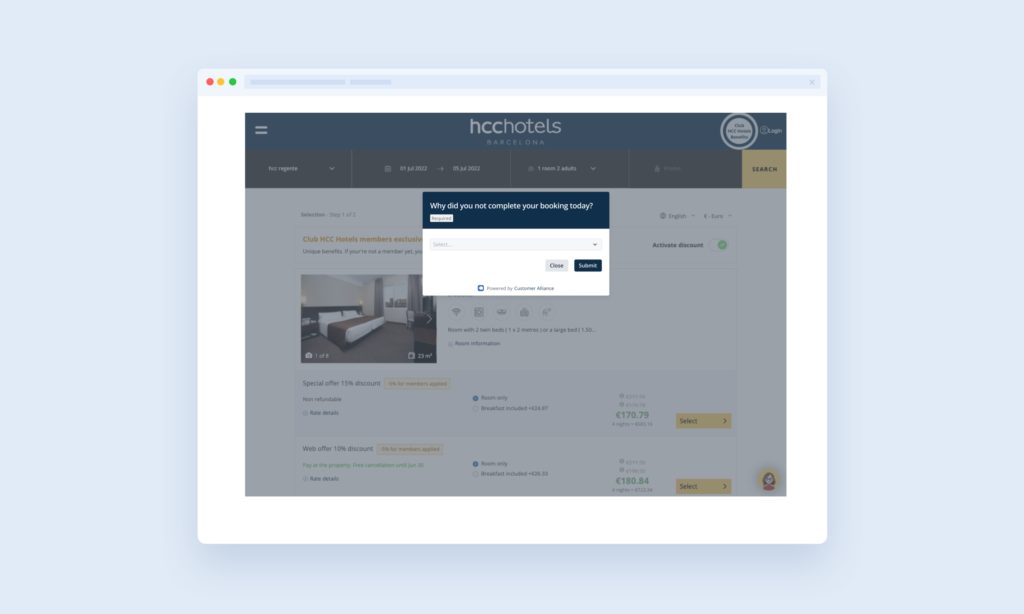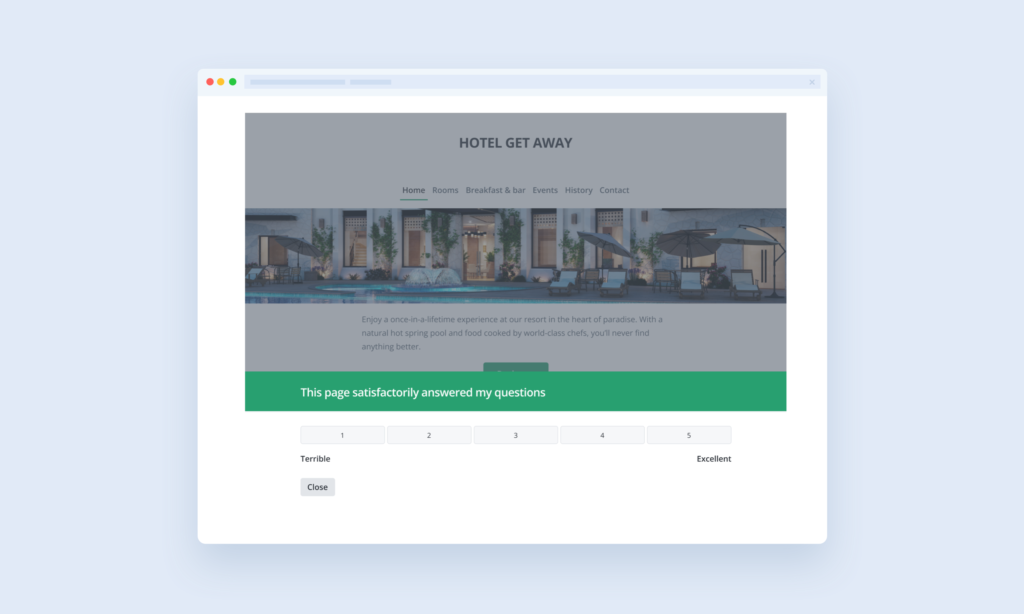Can your customers find all the information they need on your website? Are your web pages, contact forms or booking processes all working as they should? If you don’t know the answers to these questions, there’s one type of survey that’s sure to help.
In-web surveys are a great way to collect feedback from your customers and learn more about their online experience. In this blog post, we’ll share five practical ways you can use in-web surveys to make improvements to your business and maximise customer happiness. Let’s get to it!
What are in-web surveys?
In-web surveys are a type of survey that appears directly on your website. They usually ask just one key question (sometimes with a follow-up question depending on the answer). This format makes them quick and easy to complete.
By minimising the number of steps the customer needs to take, in-web surveys reduce friction. As they appear right on the screen, they also remove the need to leave the website or app to give feedback. This results in a higher response rate and even more valuable insights for your business.
In-web surveys are a popular survey type because they are relatively easy, quick and inexpensive to implement. They also allow you to reach many people in a short amount of time.
1. Understand key moments of your online customer journey
Do you want to know why customers drop off at the sign-up phase? Or why they leave your site after visiting a certain page? If you want to use in-web surveys to improve customer satisfaction, it’s important to first understand the key moments of your customers’ online journey.
There are a few key moments you should focus on:
- The moment a customer completes a task or goal on your website or app (this could be anything from signing up or making a purchase to reaching the end of a blog post)
- The moment a customer abandons a process
Transitions between customer journey stages are often the most important parts of the customer experience from a business perspective. However, they are also some of the most difficult to research. Why? Because context is critical in getting high-quality feedback.
What is the customer thinking at that moment? Why didn’t they finish that booking? Asking later just won’t get you the information you need.
By surveying customers at these key moments, you can learn valuable information about their experience with your website. You can find out what’s working well and what needs improvement. You can also identify any pain points and address them quickly.

2. Measure the success of a new online offer
Sometimes new offers don’t perform in the way we expect. In-web surveys are a great way to get quick feedback so you can tweak it according to your customers’ wants and needs.
For example, let’s say you have a hotel and launch a new online package for a stay at your hotel and the green fee for the nearby golf course. It’s likely you did a fair bit of research before creating the offer, and so you know that lots of your guests come to you specifically for golf holidays.
However, once the offer page goes live, you don’t get the bookings you had hoped for. After surveying visitors to your web page, you learn that the minimum stay of 4 nights was too long. With one simple tweak, you can adjust the offer and increase its appeal to potential guests.
In this situation, if you didn’t ask for feedback, you would have no idea why the offer wasn’t working. Sure, you could guess, but there’s always the risk that you’d be wrong.
By surveying customers after they’ve interacted with your new offer, you can get concrete feedback about what they liked and didn’t like. This feedback can help you quickly improve and plan for even better future offers.
To get the most accurate feedback, it’s important to survey customers as soon as possible after they’ve interacted with the offer page. Asking straight away makes sure that their memories are still fresh and you can get more authentic feedback. Additionally, make sure to ask specific questions about the offer itself, rather than general questions about the website.
Finally, don’t forget to follow up with customers who have taken advantage of your new offer. This follow-up survey can help you understand why they decided to take advantage of the offer, and whether they were happy with it. By learning what works (and what doesn’t), you can continue to build your understanding of your customers.
3. Identify any bugs or areas for improvement
Another way to use in-web surveys to improve customer satisfaction is to identify parts of your website that aren’t performing the way they should.
By surveying customers after they’ve spent time on your website, you can get feedback about what they liked and didn’t like. This feedback helps you make impactful changes to your website and create a far more enjoyable online experience.
Real-Life Example
Hotel Duomo wanted to learn how well their website was serving their guests and see if they could make any improvements to maximise bookings. Though they sent a post-stay survey, they had no way to collect feedback when the online experience was fresh in visitors’ minds.
Through Customer Alliance’s in-web survey, the hotel learned that some of their visitors wanted to explore the website in German. Using this insight, Hotel Duomo made steps to offer the additional language, improving the online experience and accessibility for the German market.
It’s particularly important to use in-web surveys in this way if customers can make bookings or purchases directly on your website. If there are any bugs, too many steps or the process is too confusing, chances are this is costing you a good amount of business. In-web surveys are just the thing for identifying those issues quickly so you can maximise revenue from your website.
4. Measure and track the customer experience
The single-question format of in-web surveys makes them ideal for customer satisfaction KPI questions, like:
- Net Promoter Score (NPS)
- Customer Effort Score (CES)
- Customer Satisfaction Score (CSAT)
- Customer Loyalty Index (CLI)
These metrics give you a concrete way of measuring customer satisfaction by assigning a numerical value to customer feedback. Once you have that number, it becomes much easier to track your progress over time.
As most customer journeys now begin online, your website is a great place to implement these kinds of KPIs. For many people, your website will be the first impression they get of your business. If it doesn’t meet expectations or deliver what they need, then that’s something you need to know about.
To make sure you get the context behind your scores, a follow-up question can be really valuable here. For example, if you received a low Customer Effort Score, you might want to follow up with:
- Would [feature/improvement] make your customer experience easier?
- What can we do to make [the service/action] easier?
- What made you choose this score?
By asking an additional question, you can get greater insight into your customer experience that you can use to your advantage. Want a more in-depth look at customer satisfaction KPIs? Check our our most popular article, ‘How to measure customer satisfaction KPI: NPS, CSAT, CES, & CLI‘
5. Understand why customers aren’t visiting parts of your website
It’s easy to identify and learn from customers who complete an action on your website. But it can be harder to understand why customers are not doing what you might expect when they find you online.

In-web surveys can reach customers actively using your website (who could be visiting certain pages or taking certain actions, but aren’t). For example, let’s say you’ve decided to start a blog on your website to give valuable content to your customers. You’ve hired a freelancer to write the blog posts, and are paying good money to produce top-quality content. But for some reason, your new blog page isn’t getting much traction.
With an in-web survey, you can find out why. You could ask questions like:
- Are you aware of our new blog?
- Are you interested in learning more about [topic of your blog]?
- What, if anything, might stop you from reading our blog?
These questions will give you specific insights that will help you come up with a solution. If your website visitors aren’t aware of the blog, you can try making it more prominent on your website or announcing it to your email subscribers. If there isn’t much interest in the topic of your blog, you could try a different topic relevant to your business and see if you get more hits.
Asking directly stops you relying on guesswork and helps you make changes that will really resonate with your customers.
Implement your own in-web surveys with Customer Alliance
With our complete Voice of the Customer platform, you can create quick, targeted, and perfectly timed surveys anywhere on your website. With the ability to use custom triggers, you can get the website feedback you need for all kinds of scenarios. Plus, with flexible design options and language support, you can perfectly tailor your surveys to fit your brand.
Ready to start learning about your online customer experience? Book your free, custom demo today!
